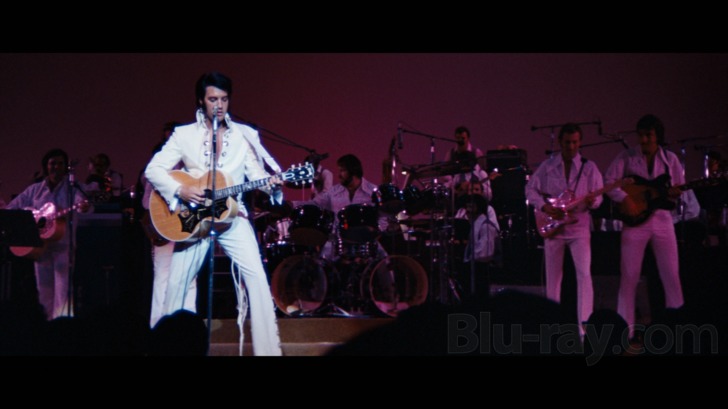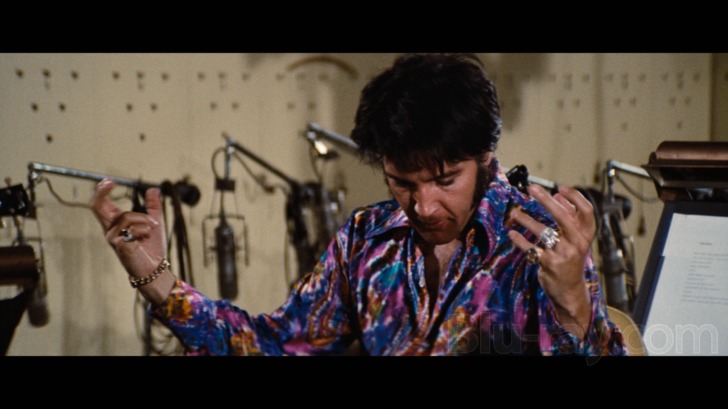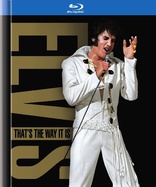Elvis: That's the Way It Is Blu-ray Movie
HomeElvis: That's the Way It Is Blu-ray Movie 
Special Edition BD w/ theatrical v. DVD / Blu-ray + DVDWarner Bros. | 1970 | 95 min | Rated PG | Aug 12, 2014
Movie rating
8.1 | / 10 |
Blu-ray rating
| Users | 4.5 | |
| Reviewer | 4.0 | |
| Overall | 4.2 |
Overview
Elvis: That's the Way It Is (1970)
Elvis Presley performs before sold-out audiences at the International Hotel Showroom in Las Vegas. This 1970 documentary includes extensive rehearsal and concert footage.
Starring: Elvis Presley, James Burton, Glen D. Hardin, Charlie Hodge, Jerry ScheffDirector: Denis Sanders
| Music | Uncertain |
| Documentary | Uncertain |
Specifications
Video
Video codec: MPEG-4 AVC
Video resolution: 1080p
Aspect ratio: 2.40:1
Original aspect ratio: 2.35:1
Audio
English: DTS-HD Master Audio 5.1 (48kHz, 24-bit)
Spanish: Dolby Digital 2.0 (192 kbps)
Portuguese: Dolby Digital 2.0 (192 kbps)
Subtitles
English SDH, French, German SDH, Japanese, Portuguese, Spanish
Discs
25GB Blu-ray Disc
Two-disc set (1 BD, 1 DVD)
DVD copy
Playback
Region A, B (C untested)
Review
Rating summary
| Movie | 4.0 | |
| Video | 4.0 | |
| Audio | 4.5 | |
| Extras | 2.5 | |
| Overall | 4.0 |
Elvis: That's the Way It Is Blu-ray Movie Review
Essential Elvis
Reviewed by Michael Reuben August 5, 2014Never one to pass up an excuse for a tie-in, Warner Home Video is using the fiftieth anniversary of Elvis Presley's film Viva Las Vegas as an occasion to release DigiBook editions of both that film and the concert documentary, Elvis: That's the Way It Is. Both are streeting during "Elvis Week", when That's the Way It Is will also have a special screening at the Orpheum Theater in Memphis. First released in 1970, That's the Way It Is captures the legendary singer during the second phase of his performing career, after his initial superstardom in the Fifties, his military service from 1958 through 1960, and his prolific reign as a box office star in the Sixties. Beginning with his Christmas Special on NBC in 1968, Elvis moved to reclaim his mantle as a top recording and performing artist of his day—the top, now that Beatlemania was over. By the time of the six sold-out concert performances at the International Hotel in Las Vegas that were filmed for That's the Way It Is, there was no question that Elvis was still The King. That's the Way It Is exists in two versions. The first, which runs 108 minutes, was the version completed by director Denis Sanders (Shock Treatment) in 1970; in addition to concert and rehearsal footage of Elvis with his band and backup singers, it devotes substantial time to interviews with fans. In 2000, producer Rick Schmidlin undertook a "reconstruction" of the film, which premiered in theaters in January of the following year. Using recently discovered footage and sixteen-track master tapes, Schmidlin expanded both the rehearsal and concert sequences. In the process, he also removed all the fan segments, so that the resulting film was twelve minutes shorter than the original, but focused entirely on Elvis as a musician, performer and beloved icon. Warner's DigiBook includes both versions of the film, but only the 2000 reconstruction has been transferred to Blu-ray. The original version is supplied on DVD, as previously released in 2007 as part of a two-disc special edition.

"Good morning, Hollywood camera!" says Elvis to the documentary crew, shortly after arriving at the MGM Music Sound Stage in Culver City (now the Sony studio) to begin rehearsing for his latest round of Las Vegas concerts. From then on, Elvis seems oblivious to the presence of cameras, even when he is explaining to the concert audience that they're being filmed. By this point in his career, the King had spent fifteen years performing in both concerts and movies, of which he'd made twenty-seven, most of them successful despite critics' dismissal. (Producer Hal Wallis is supposed to have said, "A Presley picture is the only sure thing in Hollywood.") Few entertainers were more comfortable being themselves in front of fans or cameras. The rehearsal sessions, much extended in producer Schmidlin's reconstruction, are easygoing and informal, but as the band members emphasize in their recollections, Elvis is always in charge, even when he's falling off his chair or casually throwing down his guitar. He has definite ideas about where the chorus should enter, how the harmonies should blend and the way the songs should flow. All eyes in the rehearsal room remain fixed in his direction. By comparison to modern-day concerts, with their light shows and fireworks, Elvis' stage show at the International is a simple affair, but Elvis didn't need fancy effects, except perhaps for the white jumpsuit created for his Vegas concerts that has since become a kind of trademark. As he glides around the stage, shifting easily from song to song, bending down to kiss women of all ages in the crowd, even leaping off the stage to make contact with as many fans as possible—a routine that would be almost unthinkable in today's security-obsessed environment—Elvis is his own special effect. His celebrity had achieved a unique balance between the familiar, approachable element that fans often feel with TV stars, who they experience in their homes on a regular basis, and the ethereal, otherworldly quality exuded by old-fashioned movie stars. No popular singer has ever created such harmony of these two elements to the same extent as Elvis, and That's the Way It Is captures this aspect of his stardom at its brightest and most intense. The performances are professional and energetic, although the concert has the inescapable sense of a medley that befalls any performer with a long list of hits that audiences expect to hear. What the concert recording best captures is how skilled a vocalist Elvis really was. He sounded as good live as he did in a recording studio, and he had such easy confidence that he could drop a line while bending over to smooch a fan, then pick up the lyrics without losing a breath or missing a beat. Listen to how naturally he segues from addressing the audience into vocalizing a lyric, and it becomes clear that, for Elvis, singing was simply an extension of his natural speech. Elvis was 35 when he made That's the Way It Is, and as one of the participants in the "Patch It Up" featurette notes, he was in the best shape of his life, thanks to a regimen of martial arts and the discipline of rehearsal. It's hard to imagine, watching such an unstoppable force of nature dominate the stage and woo the crowd, that he had only seven years to live. But Elvis' decline was as precipitous as his rise was meteoric. He did everything in an outsized way, for good or for ill. For all the debate over preserving the original theatrical versions of films (which Warner has done, albeit only in standard definition), Rick Schmidlin's "reconstruction" of Elvis: That's the Way It Is was a worthy effort, because Schmidlin created the single best tribute to a performing artist who was one-of-a-kind.
Elvis: That's the Way It Is Blu-ray Movie, Video Quality 

Venerable cinematographer Lucian Ballard (The Wild Bunch and the original True Grit) supervised the filming of Elvis: That's the Way It Is, which was shot in anamorphic widescreen. The image on Warner's 1080p, AVC-encoded Blu-ray is generally impressive, although some of the source-based issues probably cannot be overcome without major, labor-intensive efforts at digital workstations, especially where the "reconstructed" version uses footage that suffers from obvious fading. The good news is that none of the footage is marred by damage in the form of scratches, hairs, dirt or dust (or, if it was, the damage has been repaired). Detail is generally very good, especially when one considers the lenses and film stocks of the era in relation to the unscripted subject matter of a documentary. The rehearsal footage has less contrast, and blacks aren't as deep, compared to the concert footage with its bright lights and more intense colors, but the flatter look suits the informality of the mood in the rehearsal room. A fine grain pattern is visible throughout. To the extent that electronic manipulation was applied, it probably already occurred at the reconstruction phase. The Blu-ray image itself does not betray evidence of filtering or artificial sharpening. Warner continues to use the lowest possible bitrate, here 20.95 Mbps, which should be unnecessary in an era when BD-50s are relatively inexpensive to manufacture, but I could not see any obvious detriment to the Blu-ray image.
Elvis: That's the Way It Is Blu-ray Movie, Audio Quality 

Elvis: That's the Way It Is was originally released in four-track stereo, but the "reconstructed" version received a full-blown 5.1 remix based on the original sixteen-track masters. That mix is provided on Blu-ray in lossless DTS-HD MA, and it sounds amazing. In the "Patch It Up" documentary, it's noted that the musicians in Elvis' band heard sonic details in the remix that they had never been able to make out before, and I have no doubt that the same level of detail is present on the Blu-ray. The sense of presence is constant, whether in the informal space of the studio or in the recesses of the International Hotel Showroom. James Burton's lead guitar solos are just as vivid as Elvis' vocals. The latter, of course, switches effortlessly from soulful country-western to raucous rock 'n' roll, with every variation in between. (If you've never heard Elvis' cover of "Bridge over Troubled Waters", you should; it'll change your perception of the song.) The 5.1 remix remains faithful to the original stereo arrangement by staying largely in front, using the surrounds to create a sense of depth but nothing more. It's an excellent concert reproduction.
Elvis: That's the Way It Is Blu-ray Movie, Special Features and Extras 

The disc-based extras have been ported over from Warner's 2007 "two-disc special edition" DVD set. Although Warner is well-known for not remastering extras, the failure seems particularly inappropriate here, where the PR materials prominently list the outtakes as a special feature. Their video is exceptionally weak, and the audio, too, needs a major overhaul, so that it doesn't sound so thin and crackly.
- Patch It Up: The Restoration of Elvis: That's the Way It Is (480i; 1.33:1; 9:13): In this short featurette, producer Rick Schmidlin describes the process of re-editing the film, and members of Elvis' band share their reactions at seeing and hearing the new footage and their recollections of working with their former boss.
- Outtakes (480i; 2.40:1): These same outtakes also appear on the DVD containing the 1970 version of the film.
- You Don't Have to Say You Love Me (2:35)
- Eating Sequence (1:32)
- Cattle Call, Baby Let's Play House and Don't (4:18)
- Farther Along (1:14)
- Oh, Happy Day (3:48)
- Just Can't Help Believin' (4:37)
- Walk a Mile in My Shoes (2:39)
- I've Lost You (3:50)
- Sweet Caroline (2:45)
- Little Sister (2:59)
- Stranger in the Crowd (3:56)
- After Show Party (1:20)
- Theatrical Trailer (480i; 1.78:1, enhanced; 2:10): "Elvis! In person! As he is!"
- DigiBook: The Blu-ray and DVD are housed in a handsomely illustrated DigiBook with an extensive collection of color and black-and-white photos and several useful text additions. Complete track lists are included for both versions of the film, plus dates of recording and an overview of Elvis's career. Brief biographies of musical director Joe Guercio, backup singer Millie Kirkham, backing groups The Imperials and The Sweet Inspirations and The TCB Band are also included. Two pages of trivia and a short piece on Elvis' signature white jumpsuit round out the collection.
Elvis: That's the Way It Is Blu-ray Movie, Overall Score and Recommendation 

Elvis: That's the Way It Is wasn't made with the high concept of another great Seventies concert film, The Last Waltz, or the cachet of a historical moment such as Woodstock, but it has grown in stature along with Elvis Presley's continuing influence as an essential figure in American pop culture. The pity is that we don't have a similarly definitive record of Elvis performing in the Fifties, when he first burst onto the scene like some dangerous revolutionary figure, enchanting youth and scandalizing the establishment. When Elvis made That's the Way It Is, everyone loved him. Although Warner could have done a better job with the extras, the Blu-ray is a good presentation of the film in its "reconstructed" version and is highly recommended.
Other editions
Elvis: That's the Way It Is: Other Editions
Similar titles
Similar titles you might also like

Elvis on Tour
1972

Elvis Presley: Elvis - Aloha From Hawaii Via Satellite
50th Anniversary
1973

Elvis Presley
Elvis: '68 Comeback Special - 50th Anniversary Edition
1968

Springsteen & I
Bruce Springsteen
2013

U2: Rattle and Hum
1988

Michael Jackson's This Is It
2009

Linda Ronstadt: The Sound of My Voice
2019

Chuck Berry Hail! Hail! Rock 'n' Roll
1987

Sinatra: All or Nothing at All
2015

Marley
with Bonus Disc
2012

The Song Remains the Same
Led Zeppelin
1976

Queen Rock Montreal & Live Aid
1981

Shine a Light
The Rolling Stones
2008

Pearl Jam: Let's Play Two
2017

Depeche Mode: 101
1989

History of The Eagles Parts 1 & 2
2013

Madonna: Truth or Dare
1991

Ladies and Gentlemen: The Rolling Stones
1973

Metallica: Some Kind of Monster
2004

Tom Petty and the Heartbreakers: Runnin' Down a Dream
2007

